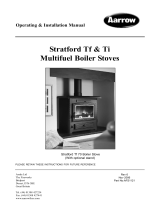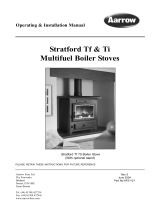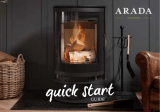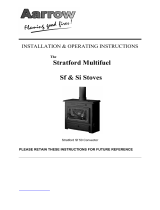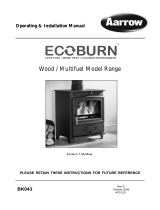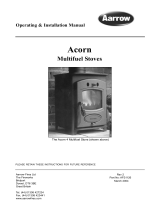Page is loading ...

Stratford Stove User Guide
Stratford Stove User Guide
June 2014
BS EN 13240:2001 +A2:2004
BS EN 13229:2001 +A1:2003+A:2004 CE
BK560 Rev06

Stratford Stove User Guide
Arada Ltd
June 2014
Congratulations on the purchase of your new Stratford stove!
More than 30 years of experience has been put into the
development of your stove to ensure ultimate performance and
years of trouble free use and enjoyment. Every detail of your
stove has been carefully designed and engineered which is why
we are so confident in the reliability of our products.
Your Stratford stove is built to the highest standard of
craftsmanship using the best materials and the most modern
equipment available. It is a highly efficient and sophisticated
piece of machinery and when properly installed and operated
it should provide a lifetime of heating satisfaction.
Should you have any questions about your stove which are
not covered by this manual, please contact the Arada retailer in
your area, call our technical support department on 44 (0)1297
35998 or visit our website www.aradastoves.com which offers a
wealth of information on how to care for, and get the best from
your stove.
Please ensure that you read these instructions in full and
understand them before operating your stove.

Stratford Stove User Guide
Arada has a policy of continuous product development and
therefore we reserve the right to amend specifications without
prior notice. Due to printing cycles, items or options may be
described before they are generally available or after they have
ceased. Please check with your retailer or dealer if you are
unsure about any aspect of your stove, its installation or correct
use.
BK560 Rev06

Stratford Stove User Guide
Contents
1 Warnings 1
1.1 Health and Safety . . . . . . . . . . . . . . . . . . . . 2
2 Advice on fuel types 2
2.1 Wood............................ 2
2.2 Solidfuel .......................... 3
3 Before using your stove 3
4 Air inlet controls 5
4.1 PrimaryAir ......................... 5
4.1.1 Airwash system / Secondary air . . . . . . . . 6
4.1.2 EasyBoost ..................... 7
5 Lighting your stove 7
5.1 Burningwood ....................... 7
5.2 Burning solid fuels . . . . . . . . . . . . . . . . . . . . . 8
5.3 Warning - Fume / Smoke emissions . . . . . . . . . . 10
6 Further information for all stove owners 10
6.1 Doorglass ......................... 10
6.2 Reduced burning . . . . . . . . . . . . . . . . . . . . . 11
6.3 Periods of non-use (summer months) . . . . . . . . . 11
6.4 Replacement parts . . . . . . . . . . . . . . . . . . . . 12
6.5 Ashremoval........................ 12
7 Further information for multi fuel stove owners 13
7.1 Multi fuel or Flexifuel grates . . . . . . . . . . . . . . . 13
8 How heat is delivered by your stove 14
8.1 Radiantheat ....................... 14
8.2 Convected heat . . . . . . . . . . . . . . . . . . . . . 14
8.3 HotWater ......................... 15
9 Ongoing care for your Stratford stove 15
9.1 Adjusting the door hinges . . . . . . . . . . . . . . . . 15
9.2 Firedoorseal ....................... 16
9.3 Crackedglass....................... 16
9.4 FEDs Inspection (where fitted) . . . . . . . . . . . . . 16
BK560 Rev06

Stratford Stove User Guide
1 Warnings
Pure Petroleum coke or Bituminous house coal must not be
burned in this appliance. The use of these fuels will invalidate
the appliance guarantee.
Arada recommends the use of HETAS approved smokeless
fuels which have been deemed suitable for use on closed
appliances, including multi fuel stoves. If in doubt, contact The
Solid Fuel Association, telephone: 0845 601 4406 / 01773 835400
or visit www.solidfuel.co.uk.
It is a legal requirement that the installation of all new or
replacement, wood or solid fuel heating appliances obtain
building control approval from your local authority. This can
be done by using a qualified heating engineer, affiliated to
a government approved competent persons scheme such
as operated by HETAS. If in doubt, contact HETAS Limited,
telephone: 0845 634 5626 or visit www.hetas.co.uk.
A fireguard conforming to BS 8423:2002 should be used in the
presence of children or elderly people. Do not use aerosol
sprays or any other flammable materials near the appliance
when in use.
Arada Ltd will not be responsible for any consequential or
incidental loss or injury however caused.
Any manufacturer's instructions must not be taken as
overriding statutory requirements.
Any further warnings in this document will be
marked out in a box such as this one. Ignoring the
warnings could lead to damage/injury to persons
and/or property.
BK560 Rev06 1

Stratford Stove User Guide
1.1 Health and Safety
Please consult health and safety guidelines for advice on
handling heavy and/or large items.
2 Advice on fuel types
2.1 Wood
As a natural and renewable fuel, wood is the first choice
for burning, however burning wood requires a little effort and
planning.
Any type of wood is suitable (though hardwood is preferable)
provided it is well seasoned and has a moisture content below
20%. This usually implies that the timber has been suitably stored
to allow moisture to evaporate for at least 9 months in the case
of soft wood, and at least 24 months in the case of hard wood.
We recommend that for general burning, wood should be split
into logs of no more than 100mm (4”) diameter.
If, when burning wood, you see signs of sticky tar inside the
appliance or chimney, your wood is ‘green’ or too wet and
requires further seasoning. An electronic moisture meter can
be obtained in order to determine the moisture content of your
wood fuel.
Paper will burn successfully. Burn dry paper only or chimney
damage will occur.
Wet wood must not be used as this will greatly
contribute to the creation of tar and creosote
which may, in extreme cases, run down the
chimney in liquid form. This will seriously damage
both the chimney and the appliance and increase
the risk of a chimney fire.
BK560 Rev06 2

Stratford Stove User Guide
2.2 Solid fuel
If you have chosen a multi/solid fuel stove this will have a cast
iron riddling grate which allows you to burn a wider variety of
fuel types. It is important to ensure that your fuel is intended for
use in a stove, modern stoves are designed for use with current
cleaner burning and smokeless fuels.
Arada recommends the use of HETAS approved smokeless
fuels which have been deemed suitable for use on closed
appliances including multi fuel stoves, these are:
•Anthracite
•Ancit™
•Coalite
Newflame™
•Homefire™
•Homefire
Ecoal™
•Homefire
Coals™
•Maxibrite™
•Phurnacite™
•Pureheat™
•Supertherm™
•Sunbrite™
•Taybrite™
For additional advice on fuels, please refer to The Solid Fuel
Association (www.solidfuel.co.uk) or HETAS (www.hetas.co.uk).
3 Before using your stove
Stratford stoves are designed to be operated with the fire
door(s) closed at all times, apart from refuelling (when alight)
or cleaning (when cold).
Never leave the appliance unattended for an extended
length of time with the door(s) open.
Prior to lighting the stove for the first time, please check with
the installer that:
•Installation and all building work is complete. (Refer to the
installation guide.)
BK560 Rev06 3

Stratford Stove User Guide
•The chimney is sound, has been swept and is free from
obstruction.
•Building Regulations and any local by-laws have been
followed during installation.
•All firebox liner panels and throat plate are in place.
•The chimney draw has been checked and is within
specification (between 0.1mb to 0.2mb, or 10-20 pascals).
This ensures your stove will operate predictably and
efficiently.
•A Carbon Monoxide detector is correctly installed in the
same room as the appliance.
Ensure that you have read and understood these instructions
before lighting the fire.
Our YouTube channel www.youtube.com/aradastoves
features a collection of videos designed to help you get the
best from your Stratford stove.
Always wear suitable protective fire gloves when refuelling
your stove, such as the Arada glove supplied with your stove.
We recommend that you light a small fire for the first few days
of use to cure the paint and allow the castings to relax. During
this process the paint surface may smoke briefly, and you smell a
slight odour for an hour or so. The vapour is harmless and should
not be confused with fume emissions, however, it is advisable to
keep the area well ventilated until the vapour disperses.
You may hear your stove ‘click’ or ‘tick’ whilst it heats up
or cools down. This is completely normal and is produced by
the expansion and contraction of the steel components in your
stove when its temperature changes.
BK560 Rev06 4

Stratford Stove User Guide
When lighting a cold boiler appliance it is not uncommon
for condensation to form when the hot air makes contact with
the cold boiler jacket. This is only temporary and no fault of
the appliance, once the boiler water temperature rises the
condensation will stop.
Some models have holes in their bases to accommodate
a heat shield. Condensation may pass through these during
the initial lighting of the stove. Please ensure your hearth is
protected from the possibility of being permeated/discoloured
by condensation.
4 Air inlet controls
Your stove has three air inlet controls. These are located either
on the stove body or the door.
The primary air inlet provides under draught to the base of
the fire chamber, the airwash system (secondary air) providing
overdraught and the 'Easy Boost' provides an on demand
increase in air for combustion. The exact controls may differ from
those illustrated in this manual but will work in the same way.
4.1 Primary Air
The primary air is supplied through the thermostatically
controlled air inlet beneath an access cover on left side of your
stove. This should have been calibrated when the stove was
installed. (See accompanying installation guide). It regulates
the amount of under draught air entering the stove depending
on the setting of the control knob.
The control knob is numbered 0 to 5 relating to the nominal
temperature of the water within the boiler jacket.
With a correctly configured installation the water in the jacket
should not exceed 80ºc when the knob is set to 5.
BK560 Rev06 5

Stratford Stove User Guide
Figure1: Setting the thermostat.
If a lower radiator temperature is required a lower number
should be selected. Some experimentation may be necessary
to find the setting best suited to your requirements.
4.1.1 Airwash system / Secondary air
The airwash has an internal sliding plate with slots, housed in
a cover plate, and is located above the fire door. Sliding the
control knob to the right as far as it will go, achieves the fully
open position. Please see figure 2.
Figure2: Airwash / secondary air controls.
Sliding the control knob to the left as far as it will go, achieves
the fully closed position.
BK560 Rev06 6

Stratford Stove User Guide
4.1.2 Easy Boost
Using the easy boost slider allows a boost of air into the stove
whilst lighting the fire and allows a rapid increase in boiler output
if required for a period of time. It should be used for short periods
only and will temporarily override the thermostatic control.
Sliding the control towards the ‘+’ symbol will increase the
amount of under draught to the grate. Moving the control
towards the ‘-’ symbol reduces the under draught.
Always close the easy boost slider if the stove is to
be left unattended.
Figure3: Easy Boost air control.
5 Lighting your stove
5.1 Burning wood
When wood is burnt it is in fact the wood gas that burns and this
requires a good supply of air coming from above the fuel. For this
reason use all the air inlets while igniting the stove, but reduce
this to air coming from the airwash system and over draught
once alight. As much as 40% of the heat from burning wood is
obtained from secondary combustion and this can be severely
hampered by air entering the fire box from below the fuel via
the primary air inlet control.
BK560 Rev06 7

Stratford Stove User Guide
1. Set the fire by using scrunched up newspaper and placing
a layer of dry kindling wood on top of this. The use of two
or three fire lighters may assist in lighting the kindling.
2. Fully open both the airwash and Easy Boost air controls and
light the fire.
3. After the kindling has caught light, you should almost close
the fire door leaving it ajar by about 20mm. This will aid flue
draw during the initial lighting of the fire.
4. The flue temperature and draw should be established after
five minutes, and the kindling reduced to form an ember
bed.
5. Carefully load the stove with well seasoned wood and fully
close the fire door.
6. After ten to fifteen minutes, close the Easy Boost air control and
regulate the airwash / secondary air system to a setting which
maintains clear glass, typically by reducing to approximately
half open.
5.2 Burning solid fuels
Solid fuel burns best with its air supply for combustion coming
from underneath the fuel.
Please do not attempt to burn Pure Petroleum coke
or Bituminous house coal in your stove. The use of
these fuels could damage your stove and will void
your warranty.
1. Set the airwash / secondary air slider to about one quarter
open and the primary air slider fully open (see section on Air
inlet controls on page 5).
2. Light as with wood fuel (see steps 1, 2, and 3 on the
preceding page), with kindling and fire lighters.
3. Once flue draw has been established, after about five
minutes, carefully load the stove with fuel and close the
door.
BK560 Rev06 8

Stratford Stove User Guide
4. When the fire is well alight close the Easy Boost slider.
5. The airwash should be opened sufficiently to keep the door glass
clean.
Whilst burning solid fuel it can be beneficial to occasionally
riddle the grate bars so any burnt fuel will fall between the grate
bars into the ash pan below.
This will ensure a good under draught is maintained. This
should be done with the supplied operating tool whilst wearing
protective gloves.
Figure4: Riddling the stove using the supplied operating tool.
BK560 Rev06 9

Stratford Stove User Guide
5.3 Warning - Fume / Smoke emissions
Warning: Properly installed, with a suitable flue or
chimney, operated and maintained correctly, this
appliance will not emit fumes into the dwelling.
Occasional fumes when de-ashing and refuelling
may occur. However, persistent fume emission is
potentially dangerous and must be investigated by
a HETAS registered installer.
Stop using the appliance if you smell fumes or see
smoke escaping.
If fume emission does persist, the following
immediate actions should be taken:
•Open doors and windows to ventilate room.
•Let the fire die or extinguish and safely dispose
of fuel from the appliance.
•Check for flue or chimney blockage, and clean
if required.
Seek expert advice from your HETAS registered
installer. Do not attempt to re-light the fire until the
cause of the fume emission has been identified and
corrected.
6 Further information for all stove owners
6.1 Door glass
The door glass should remain clear during normal burning.
However under certain conditions, such as burning at a low
rate, using damp wood or overnight burning, the glass may
become somewhat blackened. To remedy this, operate the
appliance at a fast rate. Alternatively when the stove is cold,
open the door and clean the inside face of the glass with a
BK560 Rev06 10

Stratford Stove User Guide
damp cloth or with glass cleaner (available from stove shops
and www.aradastovesandspares.com).
6.2 Reduced burning
When wood is burnt slowly in a closed appliance, it produces
moisture and tar, which will create condensation and deposits
in the chimney. This effect can be minimised by burning hard for
a short period, fifteen to twenty minutes twice a day.
To avoid chimney problems your appliance should not be
burnt at a reduced burn rate without a period of fast burning.
Fast burning is when the stove is burnt with a 'lively flame' and a
higher temperature. We also advise against stoking the fire with
wood and reducing the air intake(s) before leaving the stove
to extinguish (perhaps when retiring to bed) as this can lead
to a cooling of the stove and flue also resulting in incomplete
combustion and sooty deposits.
Over firing and chimney fires
DO NOT over fire your appliance. Firing the stove
at maximum for prolonged periods may result in
over-firing. If the chimney connector or casing
glows red the appliance is being over-fired and this
may result in a chimney fire.
6.3 Periods of non-use (summer months)
Please ensure that your stove is left clean and moving
components are well lubricated with a water repelling corrosion
inhibitor for the summer months (during periods of prolonged
non-use). If possible store the throat plate outside of the stove.
Check all moveable components at regular intervals, to ensure
they are moving freely.
Allow air movement through the stove by opening the airwash
and primary air inlet control(s) to about half way, open or leave
BK560 Rev06 11

Stratford Stove User Guide
the door ajar. This will allow a free flow of air through the
appliance thus preventing moisture and condensation forming
inside the stove and chimney. This preventative maintenance
will ensure your stove stays in the best condition for the coming
winter months.
6.4 Replacement parts
As a leading manufacturer we are conscious of being able
to support all our stove users with the supply of spare parts
to ensure your continued enjoyment and warmth from your
Stratford stove from Arada. You can find a complete list of
spares and consumables such as liners, grate bars and throat
plates as well as items to enhance its visual appearance and
efficiency such as Arada anthracite stove paint and rope kits.
All replacement parts or accessories can be ordered
from your local stove dealer or online direct from
Arada at www.aradastovesandspares.com or visit
www.aradastoves.com/support.
It is worth noting that the fitting of non-official Arada parts to
your stove may invalidate its guarantee.
6.5 Ash removal
The appliance will require ash to be removed periodically but
an ash bed of approximately 20mm (3/4”) should be maintained
when burning wood.
The ash pan should be emptied when the level of ash reaches
the top of the ash pan. On no account should the ash be
allowed to build up to touch the underside of the grate bars,
as this will greatly reduce the life span of the grate.
To remove ash use the supplied operating tool:
•Open the door of the stove, pausing briefly when ajar so as
to allow the fire to adjust to the increased air supply.
BK560 Rev06 12

Stratford Stove User Guide
•Put the fork end of the operating tool into the slots of the ash
pan and remove from the ash pit chamber.
•Empty the ash into a suitable container and replace the ash
pan into the stove, withdraw the operating tool and close
the fire door.
Warning: The ash can be very hot. Care must be
taken not to burn hands or household objects with
falling embers.
Empty only into a metal container. Even if the ash
appears cold, red-hot embers may be concealed
and could easily start a fire or cause an injury.
7 Further information for multi fuel stove
owners
7.1 Multi fuel or Flexifuel grates
The grate in your Stratford stove comprises of a series of
reciprocating cast iron bars seated on a pivoted comb. These
should come pre-assembled in your new stove.
All bars in the grate are identical, but every other bar is turned
180 degrees, with the ends of the bars marked ‘H’ sitting on the
high sections of the comb, and the ends marked ‘L’ sitting on
the low sections.
The riddling lever, either on the side or front of your stove, can
be operated with the stove operating tool to riddle ash into the
ash pan below. Only riddle the stove with the door closed unless
your stove requires you to open the door to access the riddling
mechanism. Stop riddling once red embers begin to fall into the
ash pan.
BK560 Rev06 13

Stratford Stove User Guide
After extended use it may be necessary to replace some of
the grate bars. Periodic inspection of the bars is recommended
and any damaged bars should be replaced. Also check for
obstructions that may prevent the operation of the riddling
mechanism.
8 How heat is delivered by your stove
8.1 Radiant heat
All Stratford stoves radiate heat into the room. The radiated
heat is most intense at the front of the stove and less intense the
further you move away from the stove.
This radiated heat is delivered as infrared rays which heat the
objects they strike. It is then these objects (such as the chimney
breast, hearth etc.) which heat the surrounding air.
8.2 Convected heat
Air immediately adjacent to the stove is heated as a result of
contact with its hot surfaces. This air then rises being replaced
by cooler air which is then heated and rises again.
BK560 Rev06 14

Stratford Stove User Guide
This creates a circuit or flow of air referred to as a convection
current, which helps to distribute heat around the room in which
the stove has been installed.
8.3 Hot Water
Your stove also has a boiler jacket integrated into the rear
of the stove. This is used to heat water which can be used
to heat your domestic hot water supply. Depending on the
configuration of your installation your Stratford boiler stove is
capable of heating radiators, underfloor heating and a hot
water tank.
Please speak to your installer who will be able to explain how
your stove has been connected and give some advice on how
to best utilise its heat output.
9 Ongoing care for your Stratford stove
The following items should be checked on your stove at
regular intervals to help ensure that the safe and efficient use
of your stove continues for many years to come. This should only
be done when the stove is unlit and cold.
9.1 Adjusting the door hinges
Once the appliance has been under fire for a period of time
the fire door may appear to have moved out of alignment with
relation to the door aperture or catch. This is quite normal and
due to the settling of the casting.
Doors attached with two hinges fixed to the body with screws
can be re-aligned as follows:
When the appliance is cold, open the fire door so that it is at
right angles to the front of the stove and then lift the fire door up
off its hinges.
BK560 Rev06 15
/

